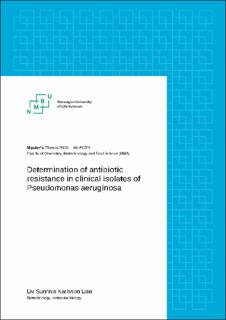| dc.contributor.advisor | Gustav Vaaje-Kolstad | |
| dc.contributor.advisor | Per Kristian Edvardsen | |
| dc.contributor.author | Lian, Liv Sunniva Karlsson | |
| dc.date.accessioned | 2024-04-10T16:27:13Z | |
| dc.date.available | 2024-04-10T16:27:13Z | |
| dc.date.issued | 2023 | |
| dc.identifier | no.nmbu:wiseflow:6983034:56771816 | |
| dc.identifier.uri | https://hdl.handle.net/11250/3125878 | |
| dc.description.abstract | Bakterien Pseudomonas aeruginosa er en gram-negativ opportunistisk patogen bakterie som
kan infisere mennesker med nedsatt immunforsvar, slik som pasienter født med den recessivt
arvelige sykdommen cystisk fibrose (CF). Bakterien er allment til stede og kjennetegnes av til
høye tilpasningsevne. P. aeruginosa er på overvåkningslisten til Verdens helseorganisasjon,
fordi antimikrobiell resistens (AMR) og til og med multiresistens (MDR) oppstår innenfor
bakteriearten [1]. I lungene til pasienter med CF kan bakterien tilpasse seg og vedvare
på grunn av den karakteristiske opphopningen av slim som ligger utenpå epitelcellene i
lungen. Eksponering av antibiotika i forsøk på å fjerne patogenet, kan føre til utvikling av
AMR. Forståelse av hvordan bakterien oppnår resistens mot antibiotika er avgjørende for
utviklingen av nye antibiotika. I løpet av dette masterprosjektet har egenskapene rundt
antibiotikaresistens til syv kliniske isolater av P. aeruginosa blitt karakterisert.
MIC ble bestemt hos alle isolatene mot de tre β-laktamene, Piperacillin/Tazobactam (TZP),
Meropenem (MEM) og Ceftazidime (CAZ), et flurokinolon Ciprofloxacin (CIP), et amino-
glykosid Tobramycin (TOB) og polymyxin Colistin (CST). PAU5 viste seg å være mul-
tiresistent (MDR). Interessant nok ble det observert store endringer i MIC-verdien mellom
testing i Mueller-Hinton Broth medium og RPMI-LB10% medium. Noen isolater viste økt
MIC-verdi i et næringsfattig medium, mens andre isolater viste en reduksjon.
Genomanalysen viste at alle isolater hadde β-laktamaser, samt ulike virulensfaktorer og re-
sistensgener som tidligere har blitt identifisert i arten. PAU1 og PAU2 hadde imidlertid
ikke efflux-pumpen MexXY-OprM (viktig for utpumping av aminoglykosider). Mangelen
på denne efflux-pumpen kunne ikke knyttes til resultatet av MIC-bestemmelsen for de to
isolatene. Det ble observert en forskjell i gener involvert i tokomponent reguleringssystem
mellom isolatene, og PAU6 hadde flest gener involvert i TCS, noe som kan forklare den lave
forskjellen sett i MIC-verdi for dette isolatet ved endring av testmedium. Til slutt ble proteo-
manalysen utført på isolatene PAU3 og PAU5, som viste resistens mot henholdsvis to og fire
antimikrobielle midler i MIC-analysen. Begge isolatene var i stand til å vokse ved den høyeste
konsentrasjonen TZP som ble testet (512/4 μg/mL). β-laktamasen ampC var det mest op-
pregulerte proteinet i begge isolatene, men i tillegg ble type VI-sekresjonssystemet observert i
PAU5 når isolatet ble eksponert for to forskjellige konsentrasjoner av TZP. Dette ble ikke sett
i PAU3. I PAU3 eksponert for den høyeste antibiotikkonsentrasjonen av TZP, ble ampC sam-
men med beskyttelsesproteiner mot ROS/NO-skade, sterkt oppregulert sammenlignet med
kontroll og den laveste antibiotikkonsentrasjonen. I den høyeste antibiotikakonsentrasjonen
viste PAU3 også oppregulering av cspD, et protein involvert i dannelse av "persister"-celler.
Konklusjonen var at oppregulering av klasse C β-laktamasen ampC var hovedårsaken til
antibiotikaresistensen mot TZP. | |
| dc.description.abstract | The bacterium Pseudomonas aeruginosa is a gram-negative opportunistic pathogen that
can infect immunocompromised patients such as patients born with the recessive hereditary
genetic disease cystic fibrosis (CF). It is ubiquitously present, and is recognized by its high
adaptability. P. aeruginosa is on the watch list of World Health Organization, due to
antimicrobial resistance (AMR), and even multidrug resistance (MDR) emerging within the
bacterial species [1]. In the cystic fibrosis lung, the pathogen is able to adapt and persist by
the characteristic thick mucus lining the epithelial cells in the CF lung. Continued antibiotic
exposure in an attempt to remove the pathogen, can result in the development of AMR.
Understanding how the bacterium is able to achieve resistance against antibiotics is essential
for development of novel antibiotics. During this master project, the antibiotic resistance
properties in seven clinical isolates of P. aeruginosa have been characterized.
MIC was determined against three β-lactams, Piperacillin/Tazobactam (TZP), Meropenem
(MEM), and Ceftazidime (CAZ), the fluroquinolone Ciprofloxacin (CIP), the aminoglycoside
Tobramycin (TOB), and the polymyxin Colistin (CST). PAU5 showed to be multi-drug
resistant (MDR). Interestingly, large changes in MIC value was seen between testing in
Mueller-Hinton Broth and RPMI-LB10. Some isolates showed increased MIC value when in
a nutrient-poor medium, while others isolates showed a reduction.
Genomic analysis showed all isolates had β-lactamases, as well as the various virulence factors
and resistance genes previously identified in the species. PAU1 and PAU2 did, however, not
have the efflux pump MexXY-OprM (important in efflux of aminoglycosides). The lack of
this efflux pump could not be linked back to the result of the MIC determination for the two
isolates. Discrepancy in genes involved in two-component regulatory system (TCS) was seen
between isolates, and PAU6 had the most genes involved in TCS which might explain the
low difference seen in MIC value for this isolate when changing the medium used for testing.
Finally, proteomics analysis was performed on clinical isolates PAU3 and PAU5, which had
showed resistance towards two and four antimicrobial agents, respectively, during MIC analy-
sis. Both isolates were able to grow at the highest TZP concentration tested (512/4 μg/mL).
The β-lactamase ampC was the most up-regulated protein in both isolates, but additionally
in PAU5, type VI secretion system was coexpressed with ampC when exposed to two different
concentrations of TZP. This was not seen in PAU3. In PAU3 exposed to the highest antibi-
otic concentration of TZP, ampC along with protection proteins against ROS/NO damage,
was seen highly up-regulated compared to control and the lowest antibiotic concentration.
In the highest antibiotic concentration, PAU3 also showed up-regulation of cspD, a protein
involved in persister cell formation. The conclusion was that up-regulation of the class C
β-lactamase ampC was the main reason for the antibiotic resistance against TZP. | |
| dc.language | eng | |
| dc.publisher | Norwegian University of Life Sciences | |
| dc.title | Determination of antibiotic resistance in clinical isolates of Pseudomonas aeruginosa | |
| dc.type | Master thesis | |
